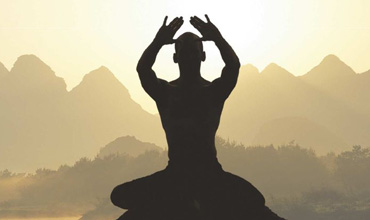Qi Gong: A physical Intervention (Complementary Therapies)

Abstract:
The word Qi means “breath of life”, Chinese explained
it as life energy in human body. It has been evolved as central concept in Chinese
medicine as a life force and flow on energy which is essential to sustain human
health and life. Qi,’’ a person’s vital energy force that circulates in the body
through channels, supposed to be produced by visualization and affirmation. Due to limitations and side effects of conventional medical
treatment, patients are increasingly utilizing complementary therapies. However,
evidence for the safety and efficacy of qi-gong treatments is limited. The purpose
of the current review was to investigate evidence for the role of Qigong in supportive
care. Literature review is conducted using the search engines, Pubmed, Google
scholar, Springer Link and CINHYL. Only scientific published articles were retrieved
from the year 2001-2016. The effects of qigong on physical and psychosocial outcomes
were examined in 28 studies and the effects on biomedical outcomes were examined
in 15 studies. RCTs with larger sample sizes reflected positive results
for the role of qigong in improving mood and fatigue parameters, fibromyalgia, cancer, diabetes
mellitus, Arthiritis, Parkinson’s disease and reducing inflammation. Moreover, qigong exercise in combination with conventional methods
had significant improvement in immune function. Hence, Qigong has encouraging
results in many of the progressive and poor prognosis diseases, hence, utilization
of Qigong by the health care providers should be supported in quality improvisation.
References:
[1]. Ageing, A. (2002).A policy
framework. World health organization,
59.
[2]. Burini, D., Farabollini, B., Iacucci,
S., Rimatori, C., Riccardi, G., Capecci, M. … & Ceravolo, M. G. (2006). A randomised
controlled cross-over trial of aerobic training versus Qigong in advanced Parkinson's
disease. Europa medicophysica, 42(3), 231-238.
[3]. Cheung, B. M. Y., Lo, J. L. F., Fong,
D. Y. T., Chan, M. Y., Wong, S. H. T., Wong, V. C. W., … & Karlberg, J. P. E.
(2005). Randomised controlled trial of qigong in the treatment of mild essential
hypertension. Journal of human hypertension, 19(9), 697-704.
[4]. Chen, H. H., Yeh, M. L., & Lee, F.
Y. (2006).The effects of Baduanjin qigong in the prevention of bone loss for middle-aged
women. The American journal of Chinese
medicine, 34(05), 741-747.
[5]. Chen, H. H., Yeh, M. L., & Lee, F.
Y. (2006).The effects of Baduanjin qigong in the prevention of bone loss for middle-aged
women. The American journal of Chinese
medicine, 34(05), 741-747.
[6]. Channer, K. S., Barrow, D., Barrow, R.,
Osborne, M., & Ives, G. (1996).Changes in haemodynamic parameters following
Tai Chi Chuan and aerobic exercise in patients recovering from acute myocardial
infarction. Postgraduate Medical Journal, 72(848), 349-351.
[7]. Conn, V. S., Hafdahl, A. R., Brown, S.
A., & Brown, L. M. (2008).Meta-analysis of patient education interventions to
increase physical activity among chronically ill adults. Patient education and counseling, 70(2), 157-172.
[8]. Choi, J. H., Moon, J. S., & Song,
R. (2005). Effects of Sun‐style Tai Chi exercise on physical fitness
and fall prevention in fall‐prone older adults. Journal of advanced nursing, 51(2), 150-157.
[9]. Freemont, A. J., & Hoyland, J. A.
(2007).Morphology, mechanisms and pathology of musculoskeletal ageing. The Journal of pathology, 211(2), 252-259.
[10]. Fouladbakhsh, J. M., & Stommel, M.
(2010, January).Gender, symptom experience, and use of complementary and alternative
medicine practices among cancer survivors in the US cancer population. In Oncology Nursing Forum (Vol. 37, No. 1).
[11]. Gatts, S. K., & Woollacott, M. H.
(2006). Neural mechanisms underlying balance improvement with short term Tai Chi
training. Aging clinical and experimental
research, 18(1), 7-19.
[12]. Galantino, M. L., Shepard, K., Krafft,
L., Laperriere, A., Ducette, J., Sorbello, A.,… & Farrar, J. T. (2005). The
effect of group aerobic exercise and t'ai chi on functional outcomes and quality
of life for persons living with acquired immunodeficiency syndrome. Journal of Alternative & Complementary
Medicine: Research on Paradigm, Practice, and Policy, 11(6), 1085-1092.
[13]. Gemmell, C., & Leathem, J. M. (2006).
A study investigating the effects of Tai Chi Chuan: individuals with traumatic brain
injury compared to controls. Brain Injury, 20(2), 151-156.
[14]. Glanz, K., Rimer, B. K., & Viswanath,
K. (Eds.). (2008). Health behavior and
health education: theory, research, and practice. John Wiley & Sons.
[15]. Hammond, A., & Freeman, K. (2006).
Community patient education and exercise for people with fibromyalgia: a parallel
group randomized controlled trial. Clinical
rehabilitation, 20(10), 835-846.
[16]. Lee, M. S., Lee, M. S., Choi, E. S.,
& Chung, H. T. (2003).Effects of Qigong on blood pressure, blood pressure determinants
and ventilatory function in middle-aged patients with essential hypertension. The American journal of Chinese medicine, 31(03), 489-497.
[17]. Lee, M. S., Lee, M. S., Kim, H. J., &
Choi, E. S. (2004).Effects of qigong on blood pressure, high-density lipoprotein
cholesterol and other lipid levels in essential hypertension patients. International Journal of Neuroscience, 114(7), 777-786.
[18]. Li, M., Chen, K., & Mo, Z. (2002).Use
of qigong therapy in the detoxification of heroin addicts. Alternative therapies in health and medicine, 8(1), 50.
[19]. Lansinger, B., Larsson, E., Persson,
L. C., & Carlsson, J. Y. (2007). Qigong and exercise therapy in patients with
long-term neck pain: a prospective randomized trial. Spine, 32(22), 2415-2422.
[20]. Li, F., Fisher, K. J., Harmer, P., &
McAuley, E. (2005).Falls self-efficacy as a mediator of fear of falling in an exercise
intervention for older adults. The Journals
of Gerontology Series B: Psychological Sciences and Social Sciences, 60(1), P34-P40.
[21]. Thomas, G. N., Hong, A. W., Tomlinson,
B., Lau, E., Lam, C. W., Sanderson, J. E., & Woo, J. (2005). Effects of Tai
Chi and resistance training on cardiovascular risk factors in elderly Chinese subjects:
a 12‐month longitudinal, randomized, controlled
intervention study. Clinical endocrinology, 63(6), 663-669.
[22]. Tsang, T., Orr, R., Lam, P., Comino,
E. J., & Singh, M. F. (2007). Health benefits of Tai Chi for older patients
with type 2 diabetes: The Move It for Diabetes Study''-A randomized controlled trial. Clinical interventions in aging, 2(3), 429.
[23]. Tsang, H. W., Mok, C. K., Au Yeung, Y.
T., & Chan, S. Y. (2003). The effect of Qigong on general and psychosocial health
of elderly with chronic physical illnesses: a randomized clinical trial. International Journal of Geriatric Psychiatry, 18(5), 441-449.
[24]. Tsang, H. W., Fung, K. M., Chan, A. S.,
Lee, G., & Chan, F. (2006).Effect of a qigong exercise programme on elderly
with depression. International journal
of geriatric psychiatry, 21(9),
890-897.
[25]. Wang, C., Roubenoff, R., Lau, J., Kalish,
R., Schmid, C. H., Tighiouart, H., … & Hibberd, P. L. (2005). Effect of Tai
Chi in adults with rheumatoid arthritis. Rheumatology, 44(5), 685-687.
[26]. Wolf, S. L., O'Grady, M., Easley, K.
A., Guo, Y., Kressig, R. W., & Kutner, M. (2006).The influence of intense Tai
Chi training on physical performance and hemodynamic outcomes in transitionally
frail, older adults. The Journals of
Gerontology Series A: Biological Sciences and Medical Sciences, 61(2), 184-189.
[27]. Yang, Y., Verkuilen, J., Rosengren, K. S., Mariani, R. A., Reed, M., Grubisich, S. A., & Woods, J. A. (2007). Effects of a Taiji and Qigong intervention on the antibody response to influenza vaccine in older adults. The American journal of Chinese medicine, 35(04), 597-607.
[28]. Yeh, G. Y., Wood, M. J., Lorell, B. H., Stevenson, L. W., Eisenberg, D. M., Wayne, P. M., … & Davis, R. B. (2004). Effects of tai chi mind-body movement therapy on functional status and exercise capacity in patients with chronic heart failure: a randomized controlled trial. The American journal of medicine, 117(8), 541-548.

